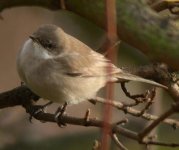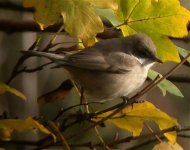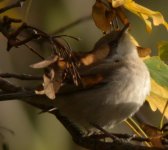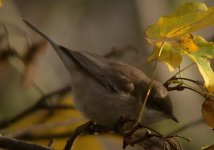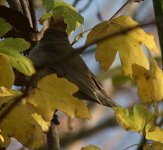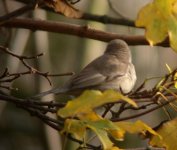-
Welcome to BirdForum, the internet's largest birding community with thousands of members from all over the world. The forums are dedicated to wild birds, birding, binoculars and equipment and all that goes with it.
Please register for an account to take part in the discussions in the forum, post your pictures in the gallery and more.
You are using an out of date browser. It may not display this or other websites correctly.
You should upgrade or use an alternative browser.
You should upgrade or use an alternative browser.
Lesser Whitethroat race ID (1 Viewer)
- Thread starter Brian Stone
- Start date
More options
Who Replied?Brian Stone
A Stone chatting
Jane Turner
Well-known member
Its been months since I saw one! Looks a bit long-winged for minula, but I;ve not seen any so I can barely claim to be an expert.
Last edited:
Real can o' worms stuff this Brian.
Birds breeding in Northern Siberia used to be called subspecies blythi and many late autiumn and winter records in W Europe were generally assumed to be this form. However, in the recent Helm monograph on Sylvia warblers the authors chose to consider blythi as synonymous with western curruca. Some birds from Siberia can look slightly different from typical curruca and show, for example, a warm tone on the wings etc.... Your bird could be one of these.
Lying south of the range of 'blythi', and forming a bridge between it and minula (the classic 'Desert' Lesser Whitethroat) is the enigmatic form halimodendri which in the north looks close to 'blythi' and in the south perhaps merges into minula. The Helm guide places halimodendri in with the northern and western curruca group though it might make just as much sense to include it in the minula ('Desert') group - it all depends on whether you're looking at a northern or a southern halimodendri I guess.
You're bird certainly does not have the very pallid and diminutive appearance of a classic minula (a form which actually bears a close passing resemblance to a Desert Warbler and even shares a similar habitat.
Without a full set of biometrics and very detailed notes on any vocalisations it's unlikely that much progress can be made but the date of your observation might indicate a bird of eastern origin, probably so-called 'blythi' or perhaps a bird from the northern parts of the range of halimodendri.
Until there is further clarification of both the appearance and vocalisations of halimodendri from various parts of its range and clarification of its relationships with both so-called blythi and minula it's unlikely that much progress can be made on this issue either.
Spud
Birds breeding in Northern Siberia used to be called subspecies blythi and many late autiumn and winter records in W Europe were generally assumed to be this form. However, in the recent Helm monograph on Sylvia warblers the authors chose to consider blythi as synonymous with western curruca. Some birds from Siberia can look slightly different from typical curruca and show, for example, a warm tone on the wings etc.... Your bird could be one of these.
Lying south of the range of 'blythi', and forming a bridge between it and minula (the classic 'Desert' Lesser Whitethroat) is the enigmatic form halimodendri which in the north looks close to 'blythi' and in the south perhaps merges into minula. The Helm guide places halimodendri in with the northern and western curruca group though it might make just as much sense to include it in the minula ('Desert') group - it all depends on whether you're looking at a northern or a southern halimodendri I guess.
You're bird certainly does not have the very pallid and diminutive appearance of a classic minula (a form which actually bears a close passing resemblance to a Desert Warbler and even shares a similar habitat.
Without a full set of biometrics and very detailed notes on any vocalisations it's unlikely that much progress can be made but the date of your observation might indicate a bird of eastern origin, probably so-called 'blythi' or perhaps a bird from the northern parts of the range of halimodendri.
Until there is further clarification of both the appearance and vocalisations of halimodendri from various parts of its range and clarification of its relationships with both so-called blythi and minula it's unlikely that much progress can be made on this issue either.
Spud
Jane Turner
Well-known member
Brian, I've been looking at a couple of theoretcially proven minula's.
http://www.surfbirds.com/media/gallery_photos/20031124072431.jpg
http://www.birdforum.net/attachment.php?attachmentid=3877
Both show 4-5 evenly spaced innermost primaries tips with narrow pale edges then a close bunch of unedged darker primaries which are less than half the total length of the paler edged ones. In your bird the relative lengths are more like equal, suggesting that your bird's wing is a wee bit less rounded than these classic minula.
Of course that doesn't mean it isn't one, but might be a pointer towards a blythi.. Off to look at some more pics to see if that is a feature that could be used in the field.
http://www.surfbirds.com/media/gallery_photos/20031124072431.jpg
http://www.birdforum.net/attachment.php?attachmentid=3877
Both show 4-5 evenly spaced innermost primaries tips with narrow pale edges then a close bunch of unedged darker primaries which are less than half the total length of the paler edged ones. In your bird the relative lengths are more like equal, suggesting that your bird's wing is a wee bit less rounded than these classic minula.
Of course that doesn't mean it isn't one, but might be a pointer towards a blythi.. Off to look at some more pics to see if that is a feature that could be used in the field.
Jane Turner
Well-known member
Here is another one, this time on Fair Isle.. if anything its got even shorter primaries.
http://www.wildlife.shetland.co.uk/pics/lw2.jpg
http://www.wildlife.shetland.co.uk/pics/lw2.jpg
Jasonbirder
Jason-occasional-twitcher
I`m no expert here but have recently done a bit of swatting up prior to seeing the Filey minula. Classic minula is a suprisingly distinctive bird - long-tailed and short winged in appearance and prone to spend time on the ground. The appearance is overall noticably paler. I`ve no experience with haliodendri.
Have you heard the bird call at all?
What features make you think it might not be a curraca?
Have you heard the bird call at all?
What features make you think it might not be a curraca?
Edward woodwood
Member
Extremely hard, if not impossible from the photo
Spud, I hear in the grapevine that previous blythii records may be reassessed.......as they are thought now to be more likely halimodendri.......
Spud, I hear in the grapevine that previous blythii records may be reassessed.......as they are thought now to be more likely halimodendri.......
Brian Stone
A Stone chatting
This bird was silent today and was spending most of its time feeding leaf-warbler-style in Field Maple. I have no reason to think it is not curraca but have no experience of other races. You don't often get views like this in the field.
Paul Hackett
Well-known member
Another "eastern" Lesser whitethroat from this year ( bird still present as of today )
http://www.portlandbirdobs.btinternet.co.uk/bpp_eastern_lesser_whitethroat_191103.htm
http://www.portlandbirdobs.btinternet.co.uk/bpp_eastern_lesser_whitethroat_191103.htm
Jane Turner
Well-known member
A similar primary pattern to the above. 4 innermost primaries with very fines pale-edged tips...a slight edge on the 5th innermost then the rest without edges and very bunched and shorter in incrememental length... I need to see some standard birds...
Paul Hackett
Well-known member
see yet another "eastern" LW @
http://www.birdpix.nl/
then look two thirds down the page at the two thumbnails and click on
N.B. in the last 3 weeks 3 estern type LWihtethroats in UK - ringed at Holme NOA, Filey Brigg and Portland Bill and full biometrics taken of each bird and now this bird in Holland ?
http://www.birdpix.nl/
then look two thirds down the page at the two thumbnails and click on
N.B. in the last 3 weeks 3 estern type LWihtethroats in UK - ringed at Holme NOA, Filey Brigg and Portland Bill and full biometrics taken of each bird and now this bird in Holland ?
Edward woodwood
Member
although it's very difficult to judge colour from photographs, some of the 'desert' types above don't actually look small or pallid/sandy enough for classic minula. I don't know about biometrics but would hazard a guess that most are more likely halimodendri.....the bird at Holme I think was this as was one at Hemsby, but I may be wrong as I got this second hand..........
is halimodendri sometimes referred to as Steppe Lesser 'throat??
is halimodendri sometimes referred to as Steppe Lesser 'throat??
Jane Turner
Well-known member
Seems that the Dutch have split them too!
Hi all,
While I have only seen nominate curruca,I feel that this bird is either a 'blythi' type or a halimodendri.I remember seeing photos of a 'classic' minula in NE England three(?) years ago in Birding World,and was struck by the short primary projection,wings that appeared almost too small for the body(as shown by Spectacled Warbler) etc as much as by the colouration of the upperparts.This bird,and some of the recent individuals claimed as minula,doesn't look as distinctive structurally,and presumably is at best a minula/halimodendri intergrade?
Harry H
While I have only seen nominate curruca,I feel that this bird is either a 'blythi' type or a halimodendri.I remember seeing photos of a 'classic' minula in NE England three(?) years ago in Birding World,and was struck by the short primary projection,wings that appeared almost too small for the body(as shown by Spectacled Warbler) etc as much as by the colouration of the upperparts.This bird,and some of the recent individuals claimed as minula,doesn't look as distinctive structurally,and presumably is at best a minula/halimodendri intergrade?
Harry H
Edward woodwood
Member
think that's prob. correct H.
Unless birds are classic minulas prob. best to be cautious as they may turn out eventually to be halimodendri
Unless birds are classic minulas prob. best to be cautious as they may turn out eventually to be halimodendri
Brian Stone
A Stone chatting
Here's another link to a presumed halimodendri
http://hem.fyristorg.com/nonne/Artsangare.html
http://hem.fyristorg.com/nonne/Artsangare.html
Last edited:
Users who are viewing this thread
Total: 2 (members: 0, guests: 2)




